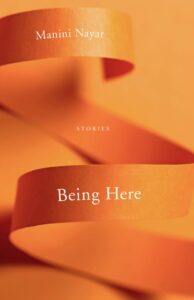
Manini Nayar, writer of “Triptych, With Interruptions,” featured in the Fall 2019 edition of Shenandoah, shares her thoughts on the power of immigrant stories and her experience writing Being Here, in the essay below. Read “Triptych, With Interruptions” here.
Notes on Revisiting the ‘Immigrant’ in Immigrant Writing
In writing my collection of stories, Being Here, some questions concerning the landscape of immigrant fiction arose in the process and remain elusive to this day. Answers are more shaded than memories.
I came to the US with the proverbial (and actual) suitcase and $200. That was the amount approved by the Reserve Bank of India in accordance with currency exchange conditions at the time. Before we knew it, the phrase became a means of introduction between fellow immigrants.
I came here with 200 dollars and a suitcase, we said to one another.
Me too, we said to one another.
We were immigrants.
It was a sort of promise and a signaled solidarity.
We would make it.
Today the phrase would have become a meme or a TikTok dance routine. Yesterday it was an affirmation, half bravado, half conviction. Our mantra for America.
Stories are a kind of currency as well, the kind that buys you time and modes of reckoning. I read through reams of immigrant narratives over the years, while my other self became the Passable Expectation. I was a mother, wife, academic, all at once and in constant disorder. I was neither an engineer nor a doctor. I was a reader, though, and sometime writer. In the spaces between India and the United States, there was the possibility of a new dynamic neither buzzwords like cultural alienation or nostalgia could fill. Something both within and beyond the divide.
Immigrant stories are powerful tales, but as a reviewer once remarked, many are stories that cover a familiar arc. We came. It was hard. Here we are. It is, in short, the story of America.
When I think of this rich narrative trajectory, something stirs, an insistent if indefinable absence. For me, and I think for many others, what we left behind is embedded into the story of our arrival. The self we carry is a singular thing, and we do not so much recreate as refurbish it.
Beyond the arc of conflicts and accommodations and renewal, all inevitable in the process of an immigrant’s reconstitution, are the boisterous private narratives of human connections and losses. This perspective through a keyhole, from an inverted telescopic point of perception, is certainly more privileged than other, rawer stories of poverty and persecution and wars left behind. But it is still a story we can tell, of racial and gendered challenges, of our own unstable prejudices, of our imperfect, willful striving as we clear the dust and settle into our individual spaces.
This way of seeing, of the single wanderer, the itinerant but not desperate migrant who travels across borders in search of a myriad of selves, is at the heart of a certain kind of travel story. Both emigrant and immigrant, the one who leaves and the one who arrives, this story tells of restless global individuals who fold their past into America, seeking harmony and continuity rather than reinvention and change.
As the new century picks up its pace, this global immigrant seems one whose life is sequential but not fractured. The old country for this migrant is as resonant and complicated as this new one, and out of the slurry comes a Hegelian reality of fresh sensibilities and experiences. The globalized immigrant is as much at ease with masala dosa as with the next shopper at Target buying China-manufactured Christmas wreaths.
But can a collection of such single stories build a worldview or represent an ethnic people in a country of immigrants, if each character is a prickly insularity?
E.M. Forster would think not. In his essay “Notes on the English Character,” he argues that characters in life and fiction are not only individuals but types, but I doubt Forster was describing this particular translator and merger of selves, the immigrant writer. He was, in fact, outlining the Englishness of the English, whose character, he determined “…is essentially middle-class”. His statement though raises uneasy questions about the quest for ‘authenticity’ in recent immigrant writing in terms of contextualization, audience, and valuation.
Fiction, Forster tells us, grows out of a social context. It mirrors that context and people within that context. “I spoke as a member of a prudent middle-class nation,” announces Forster, discussing his rocky relationship with an Indian friend, Masood, who “spoke as an Oriental,” with “a tradition…of kingly munificence and splendor.” The twain apparently could not meet, Forster explains, because individuals are not only implicated in the wider social order but shaped by it. In other words, their being is inseparable from their identity, another catchword now becoming, for better or worse, a means of literary measure. Identity, the collective set of characteristics and cultural markers by which a person is recognizable and understood, becomes a shorthand for authenticity. One might argue that Forster was describing a colonial context constructed on rigid power differentials, where the Other was subject to broad categorizations by the colonizer. But now, so many years later and in functioning democracies, we still echo Forster in questioning whether characters in fiction are recognizably Indian-enough or Chinese-enough or anything ‘enough’ to come across as fully realized individuals. And what if types turn into stereotypes, no matter how nuanced and sensitively drawn? The danger is that in constructing ‘identities,’ the writer can fall into comfortable stereotypes to interrogate without undercutting embedded negative assumptions about ethnicity and race.
Further, in the imperative to establish a visible community and voice within an existing dominant audience and culture, the immigrant writer’s efforts at representation can veil, even erase, the untypical. Can stories, however urgent and beautifully rendered, of broad and important themes of social equity and survival (“Here we are”) set unintentionally unspoken modes of literary expectation — a standard to be followed, even required? Khaled Hosseini’s The Kite Runner set a precedent a couple of decades ago, and today younger Afghan American writers like Jamil Jan Kochai carry this literary lineage into heartfelt refugee stories set in American suburbia. In a similar vein, but on a smaller thematic scale, the Canadian-Laotian writer Souvankham Thammavongsa weaves an affecting narrative around a single moment of dispossession — her father’s humiliating inability to pronounce the word ‘knife’– redeemed by the family’s quietly asserted sense of renewal. From a scale of searing tragedy to private embarrassments, the fiction of displacement, alienation and restoration constructs its own anticipated tropes, those that fit our unsettled national zeitgeist. The market responds eagerly. Books are sold. And a de facto question then arises. Does an American publishing house seek explorations of cultural identity and uplifting stories of survival by immigrants as a selling point to mainstream audiences eager to assuage their guilt, or less politically, to be better educated? Given the history of publishing, the answer, simply, is yes.
Not only publishing houses, but minority communities themselves are invested in advancing notions of collective characteristics and culture, often idealized and self-affirming. Within Indian communities across the US, the anxiety of being represented positively (“because so many ‘bad’ things have been said about us already”) roots itself in an expat national pride (“We come from a great and ancient culture”). Tell it as we wish to be seen, as we know who we are. In a related context, one thinks of a scene in Maya Angelou’s autobiography I Know Why the Caged Bird Sings. The child narrator is scrubbed to the bone and dressed in her Sunday-best (even to the extent of “freshly starched and ironed underclothes”) by her grandmother, all for a visit to a white dentist, because the girl must be “arranged” for respectability in the “whitefolks part of town.” This is how we wish to be seen. This is who we know we are.
The genuine depredations of historical racism, and its corollary, fear, cross over into the immigrants’ need for representations of the collective as an idealized offering. Injustice wears its underclothes in motley. But does the depth of injustice revealed and countered mark the limits and the value of an immigrant’s literary voice? Should the writer be required to negotiate these questions with this lurking Angel in the House?
None of this is to contest the many powerful, nuanced stories of immigrants crossing borders, of making it bravely through trauma, and for the better, into the new world. It is, though, to suggest another, but not substitutive, space for exploration, one that celebrates an immigrant story that falters, the less-than-plucky footfall, the voice lifted but lost in its own inner echo chambers. Presentations rather than representations, so that every flawed and uncommon common immigrant can sing America too.
It may tell a story not of pushback and consolidations, but of a dynamic like static or fairy lights, bright and flickering and fading in endless loops, and often without resolution or triumphs. Life itself, as it was in the old country, as it is in the new, mundane and magical in its stubborn everyday persistence. Not a life unaware of history nor ungrateful for the rich traditions of immigrant narratives, but one free to range any messy inward landscape and to speak its own contradictory and unresolved truths.
And so I look for these characters in stories of the average and the imperfect, each a contained incompleteness. I hope they claim their experience in a future full of memes or fading Angels, or whatever comes next in a connected world. They still have 200 dollars and a suitcase. Their stories are beginnings.
